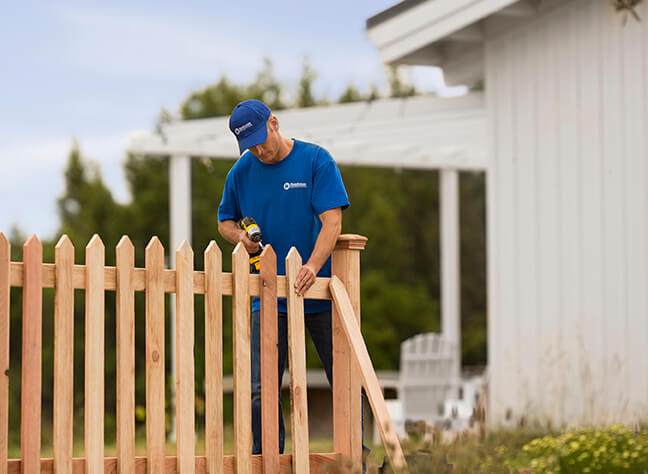Wooden fence comes in a variety of styles, including stockade, picket, lattice, post-and-rail, and shadow box. They can also be stained or painted in a wide range of colors.
Tropical hardwoods like Brazilian walnut and cumaru are another option for outdoor wooden fences. They have natural beauty and are resilient, but they also come with a higher price tag.
A wooden fence is a great way to improve the value of your property while adding privacy and security. However, the longevity of a wood fence depends on a few factors, including the type of wood used and external forces like weather. The more durable types of wood are cedar and redwood, which can last for decades with regular maintenance. In addition, some woods are naturally resistant to rot and insect infestation, while others, like pine or oak, are more prone to these problems.
When choosing wood for your fence, it is important to consider your local climate and your budget. For example, some woods are better suited to wetter climates than others, like cedar and cypress. While these types of wood are more expensive than other options, they can also last for decades.
Another consideration is the type of infill board. In-fill boards are the slats that make up the majority of your wooden fence and can be made from a variety of materials. Common in-fill board materials include pine, cedar, and cypress.
It is important to choose high-quality wood when building a wooden fence because the material will have a significant impact on the durability of your fence. A good wood will stand up to a variety of environmental conditions and resist the effects of rot and pests, which are common issues for fences.
Wooden fences are also easy to maintain because they are less prone to damage than other types of fencing. Wooden fences can be cleaned with soap and water to remove dirt and debris, and they can be treated with wood treatments and staining solutions to protect them from the elements. It is a good idea to inspect your fence regularly for signs of damage or wear, such as dark spots or cracks, and to repair any damages immediately.
Easy to maintain.
When properly maintained, a wooden fence can last for years. To ensure that it’s able to resist the elements, you should clean and stain the wood once a year. It’s also a good idea to check for signs of damage on a regular basis, such as loose boards or rusted hardware.
To clean a wooden fence, start by rinsing it with water. This will remove any debris that may have accumulated over time, such as leaves or dirt. Then, use a pressure washer to spray the wood. It’s important to keep the pressure low and move the wand in a consistent motion. Doing so will help prevent the wood from becoming splintered.
If your wooden fence has particularly stubborn stains, you can try using a wood cleaner or mildew remover. These products can be purchased at most home improvement stores. You should also consider hiring a professional to pressure wash your fence a couple of times a year. A professional will have the proper equipment and knowledge to attack difficult stains, like mold or algae, with ease.
The most vulnerable part of a wooden fence is the posts. This is because they are in direct contact with the ground and can be subject to heaving due to winter freeze-thaw cycles. To avoid this, make sure that the posts are buried at least 6 inches into the ground. Then, coat them with a wood preservative. Also, be sure to replace any nails that have rotted or come loose. This will prevent the posts from splitting or rotting in the future. Finally, be sure to inspect the hardware and re-tighten any loose screws or bolts. You can also use waterproof glue to repair split or broken pieces.
Aesthetics.
In many cases, homeowners and business owners choose wood fences for their aesthetics. They can enhance the look of a home or create a unique look that stands out from the rest of the neighborhood. Wood fences can come in a wide range of colors and stains, allowing them to complement any color scheme. They can also be painted with a variety of finishes, such as water-resistant paint. They can even be stained and carved to make them more visually appealing. Additionally, wood fences can be topped with panel heads in different styles, such as dog-ear and French Gothic, to further enhance their aesthetic.
Another benefit of wood fences is that they can be customized to fit the needs of a particular home or business. For example, some people prefer to use a more rustic style for their fencing, while others like to match it with the surrounding landscape. Additionally, wood fences can be stained and painted to help protect them from damage caused by UV rays. Additionally, some types of wood are more resistant to weather conditions than others, so it is important to consider the location and climate before selecting a fencing material.
For homeowners, a wooden fence can provide a natural and appealing appearance that complements the surrounding landscape. It can also add privacy and security to a building. In addition, it can provide protection for children and pets. Additionally, it can be used to block out noise or limit access to areas that are dangerous, such as pools. Lastly, it can be used to block out neighbors’ views of a backyard pool or other area. In addition, it can be a cost-effective option for schools and businesses.
Privacy.
Wooden fences offer privacy by creating a barrier between you and your neighbors. They’re also a great option for protecting garden areas, as they can keep animals and other pests away from your plants. There are a wide range of styles available, so you can choose the one that best fits your home and aesthetic preferences.
You can find wooden fencing in a variety of materials, but cedar is often considered the top choice because it’s naturally resistant to rot and weathering. It’s also more affordable than some other types of wood, but it may need to be treated more frequently. You can find other options, including pressure-treated pine and redwood, for a more budget-friendly but equally durable choice.
Another benefit of wooden fences is that they’re easy to customize with various paint and stain options. You can also choose to add a lattice topper for added privacy and a more decorative look. Lattices are usually made of diagonal slats that create diamond-shaped holes, and they’re available in a wide variety of heights.
Wooden fences are easy to build and can be a great DIY project for homeowners who have the time, tools, and skillset to do it. However, they’re not a good idea for beginners who lack the proper power tools and knowledge of safety techniques. Hiring a professional contractor is an excellent way to ensure that your fence is built correctly and stays safe throughout its lifetime.
A wood fence can be a beautiful addition to your yard, and it’s also an attractive selling point for potential buyers when you decide to sell your property. A well-maintained fence can significantly increase your property’s value and can also make it safer for children, pets, and other residents.
Security.
Wood fences are a great way to keep unwanted intruders off your property. They can also provide a safe environment for children and pets to play or use the bathroom. Choosing the right type of wood for your fence is essential to ensuring it will be long-lasting and secure. Some of the most popular types of wood for fencing include cedar, cypress, and redwood. These types of wood are rot-resistant and contain natural insect-repelling oils that help protect against pests.
To make sure your wood fence is sturdy enough to deter trespassers, it’s important to choose the right kind of wood and installation method. Some types of wood are more prone to rotting and other forms of damage than others, so it’s important to find the right fit for your climate. For example, if you live in an area with high humidity, you’ll want to choose wood that can resist decay.
Another factor that will affect the security of your wooden fence is its height. A taller fence will be more difficult to climb, which can deter intruders. You can also increase the security of your fence by adding a layer of concrete around its base.
Another way to boost your fence’s security is to install anti-climbing spikes. These spikes are designed to discourage trespassers by making it impossible for them to climb the fence without hurting themselves. However, it’s important to note that these spikes can be dangerous even for homeowners if they aren’t properly installed. It’s also a good idea to plant thorny plants near your fence to further deter burglars. This will not only deter them, but it will also add to the aesthetic of your home.



